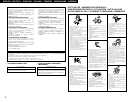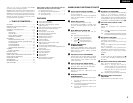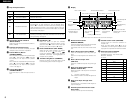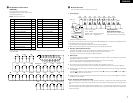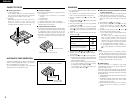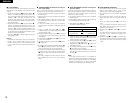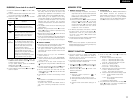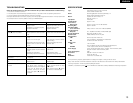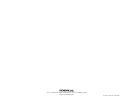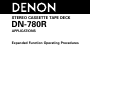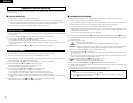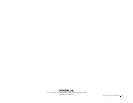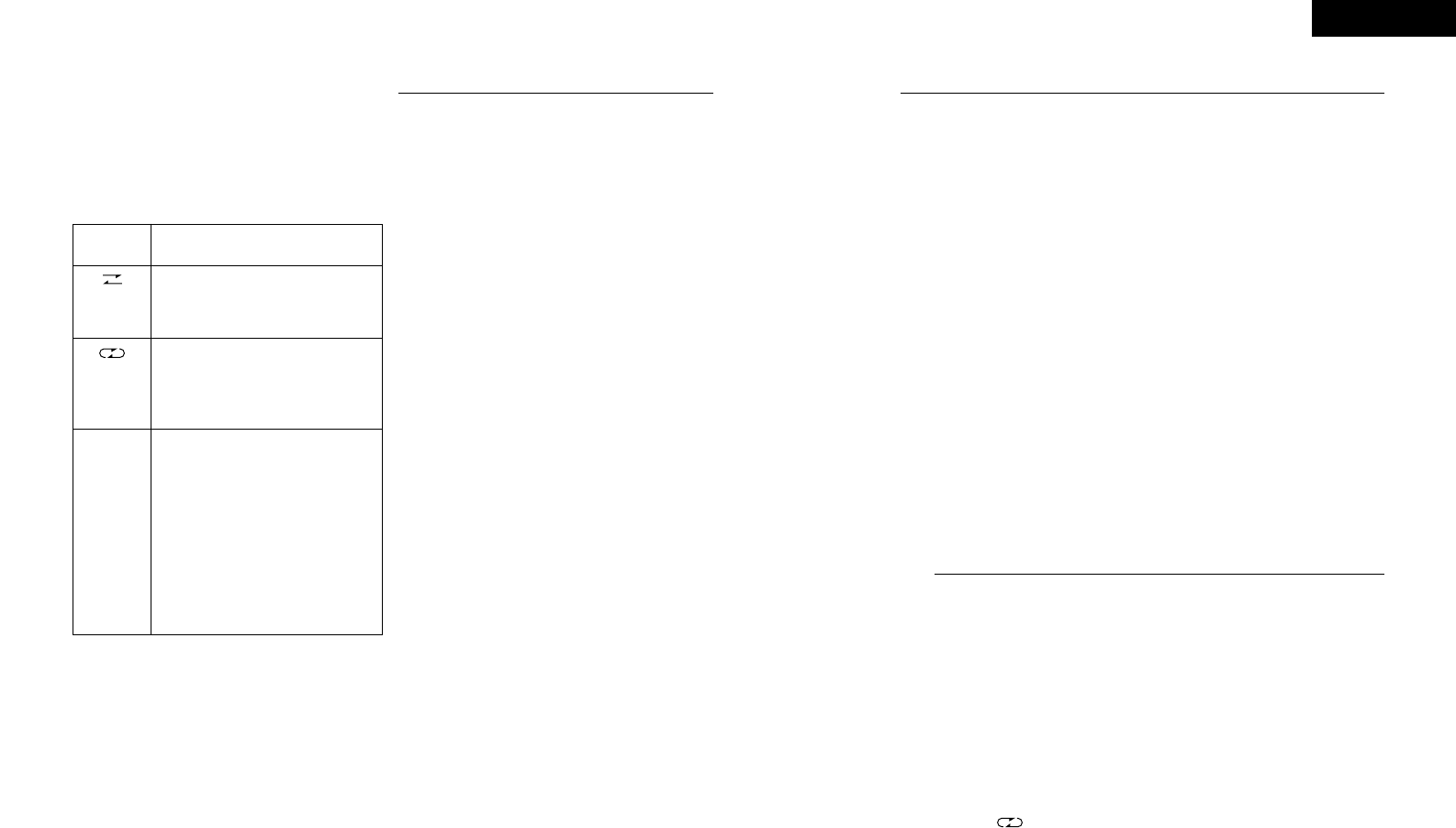
11
ENGLISH
DUBBING (from deck A to deck B)
q Press the POWER switch q to the ON ( ¢ )
position.
w Load the cassette tape to be played in deck A and
the one to be recorded in deck !9, !6.
e Select the type of tape transport with the REV.
MODE button @0.
Operation
Reverse
mode
Dubbing is performed only for one
side.The decks stop when either
deck A or B reaches the end of the
tape.
During dubbing of the side facing
you, the deck that first reaches the
end of the tape will stand by until the
other deck reaches the end of the
tape, then both decks will reverse
the tape direction together.
(Depending on the manufacturer, the
length of tapes having the same
recording time may differ somewhat.
Setting this mode permits the
arrangement of the beginning portion
of the opposite side of the tape.)
RELAY
or
CASCADE
The tape direction is reversed on
each deck when they reach the end
of the tape. (This is convenient for
dubbing to a tape with a different
length.)
r To begin normal speed dubbing, press the
DUBBING SPEED NORMAL button r. The DUB
indicator will light at this time.
To high speed dubbing, press the DUBBING
SPEED HIGH button r.
The HIGH indicator will light at this time.
t To stop dubbing, press the Stop ( 2 ) button !4 of
deck A or deck B.
• When dubbing, the recording level and the Dolby
NR coding will be the same as those of the
playback tape, regardless of the positions of the
INPUT LEVEL control and the DOLBY NR switch.
• When listening to the playback sound during
normal speed dubbing, set the DOLBY NR switch
to match the Dolby NR system with which the
playback tape was recorded. This will assure
correct sound reproduction, but does not affect the
recording.
• The playback sound cannot be heard during high
speed dubbing.
• Operation using the Rec/Rec Mute ( 4 ) and Rec
Pause ( 3 ) buttons of deck B is permitted during
normal speed dubbing.
• Buttons other than the Stop ( 2 ) button cannot be
used during high speed dubbing.
• In the normal speed dubbing mode, play signals are
only output from the DECK A LINE OUT jacks. In
the high speed dubbing mode, no sound is output.
2 MANUAL DUBBING
• With this function, the signal played on Deck A can
be recorded manually on the tape in Deck B.
• The manual dubbing function is also used to record
the signal of the Deck A tape with which the
microphone input signal has been mixed onto the
tape in Deck B.
q Perform steps e to t in the “PLAYBACK”
section on Deck A.
w Perform steps w to t in the “RECORDING”
section on Deck B. Set to Deck B INPUT SELECT
switch to Deck A.
e Set deck A to the play mode and adjust the
recording level using the INPUT LEVEL-B control
y.
r Connect microphones to the MIC jacks !1 and set
the MIC MODE switch !2 to the “REC” mode.
t Set the microphone input level with the MIC
INPUT LEVEL control !3. Also set the MIC AGC
switch !0 to “ON”.
y Start playback on Deck A and recording on Deck
B.
NOTE :
This operation is not possible if the reverse mode is
set to RELAY or CASCADE.
To prevent noise, set the MIC MODE switch to
“off” when connecting microphones to the MIC
jacks.
MEMORY STOP
1. MEMORY STOP Operation
(1) During recording or playback, the Memory
Stop feature can be used to locate a particular
point on the tape. Press the COUNTER
MEMO button at the desired point.
(2) The MEMO indicator lights.
(3) When the Rewind ( 6 ) button is pressed
during forward tape travel ( 1 ), or the Fast
Forward ( 7 ) button is pressed during
reverse tape travel ( 0 ), the tape is rapidly
rewound (or advanced) until the counter
indication of “‚‚‚‚” is reached.
• The Memory Stop feature will rewind or forward
the tape to within
_
5 counts in the forward ( 1 )
direction (from “‚‚‚‚” to “
_
‚‚‚fi”) and to within
+5 counts in the reverse ( 0 ) direction (from
“‚‚‚‚” to “‚‚‚fi”).
• The Memory Stop function operation independently
in both directions for deck A and deck B.
Caution :
If the memory stop operation is performed after
repeated fast-forwarding or rewinding, the tape may
not stop at the proper position.
2. Display Back-up
The COUNTER VALUE, MEMO, DIRECTION and
REV. MODE functions are protected for
approximately one month by a memory back-up.
Once the back-up period is up, the MEMO
settings are set to off, the DIRECTION setting is
set to 1, and the counter is reset to “‚‚‚‚”.
PRESET FUNCTION
• Use these functions to preset the DN-780R’s
operation modes. These presets are stored in
permanent memory, so they are not cleared even
when the power is turned off.
• The preset procedure can be performed in the stop
mode of both the deck A and deck B.
q Press the Stop ( 2 ) button !4 on Deck A and the
Stop ( 2 ) button !4 and REV. MODE button @0 on
Deck B simultaneously.
w Press the Play ( 1 ) button !4 on Deck A and
select the preset item.
Preset items :
1) Setting of number of cycles for “ ” or
“RELAY MODE”
2) Setting of power on play mode (on or off)
3) Setting of infrared remote control codes to be
received
4) Infrared remote control sensor setting (on or
off)
e Press the Play ( 1 ) button !4 on Deck B to
change the settings.
1) Number of cycles for the relay mode
“Loop 01” : Stop relay play after 1 cycle.
*“Loop 05” : Stop relay play after 5 cycles.
“Loop 10” : Stop relay play after 10 cycles.
2) Power on play setting (on/off)
“P-on P on” : Power on play on
*“P-on P oFF” : Power on play off
3) Infrared remote control codes to be received
*“rc dnon”: Receive Denon codes.
“rc rc-5”: RC-5 codes can be received.
4) Infrared remote control sensor setting (on/off)
*“ir on”: Accept infrared remote control
signals.
“ir oFF”: Do not accept infrared remote
control signals.
“*” indicates the default setting.
r The preset mode is canceled when the Stop ( 2 )
button !4 on Deck A or Deck B is pressed. The
settings are written at this time.




